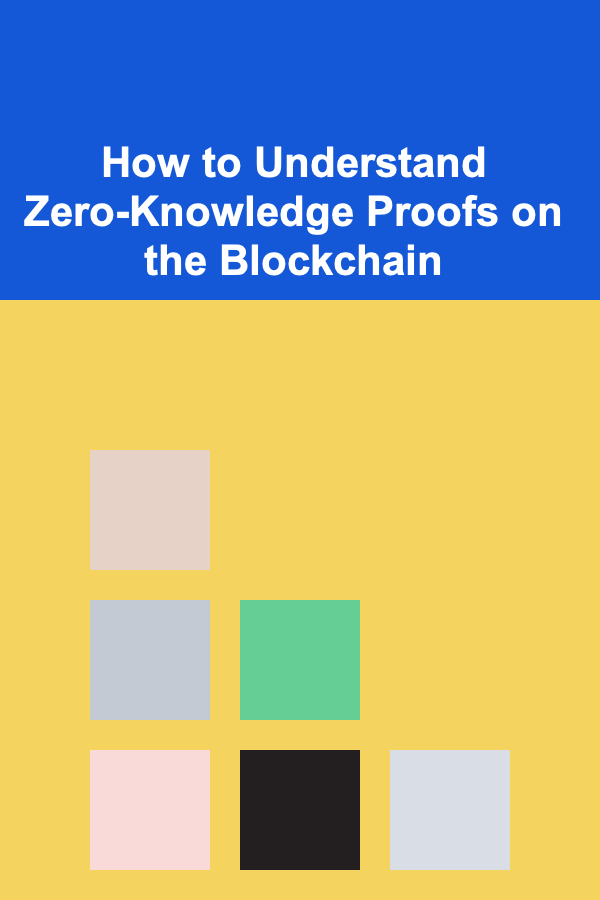
How to Understand Zero-Knowledge Proofs on the Blockchain
ebook include PDF & Audio bundle (Micro Guide)
$12.99$5.99
Limited Time Offer! Order within the next:

Zero-Knowledge Proofs (ZKPs) have garnered significant attention in the realm of blockchain and cryptography due to their ability to enhance privacy, security, and scalability. This article will break down the concept of Zero-Knowledge Proofs, how they work, and their relevance and application within the blockchain ecosystem. By the end, you will have a comprehensive understanding of how ZKPs contribute to the evolution of blockchain technology.
Introduction to Zero-Knowledge Proofs
At its core, Zero-Knowledge Proofs are cryptographic methods that allow one party (the prover) to prove to another party (the verifier) that they know a piece of information, without revealing the information itself. This is like proving that you know a password without actually revealing the password to the verifier.
The term "zero-knowledge" comes from the fact that the verifier learns nothing other than the truth of the statement being made. Essentially, the prover's knowledge is validated, but no additional information is disclosed.
Why Are Zero-Knowledge Proofs Important?
Zero-Knowledge Proofs offer a significant advantage in many contexts, especially in the world of blockchain:
- Privacy Preservation: ZKPs enable individuals to verify transactions or claims without revealing sensitive data. This is particularly useful in blockchain, where transparency is often a double-edged sword, exposing valuable private information.
- Scalability: ZKPs allow for the compression of large amounts of data, making it possible to store and validate transactions in a way that doesn't require revealing the entire set of data.
- Security: ZKPs can be used to prove the validity of actions or transactions without exposing the underlying data, reducing the attack surface for malicious entities.
How Zero-Knowledge Proofs Work
In order to understand how ZKPs function, we need to explore the three essential properties of a Zero-Knowledge Proof:
1. Completeness
Completeness ensures that if the statement is true, an honest verifier will always be convinced by an honest prover. In other words, if the prover knows the secret (or the statement is correct), they will always succeed in convincing the verifier.
2. Soundness
Soundness ensures that a dishonest prover cannot convince the verifier of a false statement. Even if the prover tries to cheat by lying, the verifier will, with high probability, be able to catch the deception.
3. Zero-Knowledge
This is the defining feature of Zero-Knowledge Proofs: the verifier learns nothing about the secret or the statement, other than the fact that it is true. The verifier does not gain any knowledge about the information the prover is trying to prove, except for the validity of the claim.
Example of Zero-Knowledge Proof
A common example used to explain ZKPs is the "Ali Baba Cave" analogy:
- Imagine there is a cave with a circular path. The prover is at one end, and the verifier is at the other.
- The prover wants to prove they know the secret password to open a door that exists in the cave without actually revealing the password.
- The verifier asks the prover to take either the left or right path in the cave. The prover can only prove that they know the secret if they consistently come out of the correct side (left or right) when asked.
- After several rounds of this challenge, the verifier becomes convinced that the prover knows the password, without ever being told what the password is.
This scenario illustrates how Zero-Knowledge Proofs can establish trust and verify claims without revealing sensitive information.
Types of Zero-Knowledge Proofs
There are different types of Zero-Knowledge Proofs, each with unique advantages and trade-offs:
1. Interactive Zero-Knowledge Proofs
Interactive ZKPs require the prover and verifier to engage in multiple rounds of communication. In this process, the prover sends a sequence of messages to the verifier, and the verifier responds with challenges to test the prover's knowledge. The conversation continues until the verifier is satisfied with the proof, at which point the verifier can be confident that the prover knows the secret.
However, the interaction between the prover and the verifier can be computationally expensive and time-consuming.
2. Non-Interactive Zero-Knowledge Proofs (NIZKPs)
Non-Interactive ZKPs (NIZKPs) eliminate the need for back-and-forth communication between the prover and the verifier. Instead, the prover can generate a proof once and send it to the verifier, who can then verify the proof independently.
This type of ZKP is highly efficient and scalable, making it particularly useful for blockchain applications. In practice, NIZKPs are more common in blockchain technologies as they allow for faster and more efficient verification processes.
3. Succinct Zero-Knowledge Proofs
Succinct ZKPs are a subclass of ZKPs that aim to reduce the size of the proof itself, allowing for rapid verification without requiring significant computational resources. This property is crucial in the context of blockchain, where efficiency and scalability are key considerations.
A prime example of this is zk-SNARKs, a type of succinct ZKP that has become popular in blockchain projects like Ethereum.
Zero-Knowledge Proofs in Blockchain
Zero-Knowledge Proofs are a game-changer for blockchain technology, particularly because of their potential to enhance privacy, scalability, and security. Let's explore the primary applications of ZKPs in the blockchain space:
1. Privacy-Preserving Transactions
One of the most well-known applications of Zero-Knowledge Proofs in blockchain is the creation of privacy-preserving transactions. Privacy coins like Zcash leverage zk-SNARKs to enable users to make transactions on the blockchain while keeping their details (e.g., sender, receiver, and transaction amount) confidential.
In these systems, ZKPs ensure that while the transaction is recorded on the blockchain for validation, no one can see the details of the transaction. This offers a level of confidentiality that is otherwise difficult to achieve in traditional blockchain systems, where all transactions are publicly visible.
2. Scalable Blockchain Solutions
Blockchain networks face significant scalability issues, especially as they grow in size and user base. One of the challenges is the high cost of storing and validating large amounts of data. Zero-Knowledge Proofs offer a solution by allowing large transactions or datasets to be verified without revealing all the underlying information.
zk-Rollups, a Layer 2 scaling solution on Ethereum, is a prominent example of how ZKPs can be used to scale blockchains efficiently. zk-Rollups aggregate multiple transactions into a single proof, which is then posted on the main blockchain. This allows for much greater transaction throughput without sacrificing security or decentralization.
3. Identity and Authentication
Zero-Knowledge Proofs can be used to prove an identity or authenticate a user without revealing any personal information. For example, ZKPs can allow users to prove they are over 18 without disclosing their exact age or even their birthdate.
In blockchain applications, this can be particularly useful for decentralized identity systems, where users can prove specific attributes (e.g., their age or location) without disclosing their full identity.
4. Smart Contract Privacy
Smart contracts on blockchain networks like Ethereum are typically transparent, meaning anyone can see the logic and state of the contract. While this is useful for auditability, it can also expose sensitive business logic or financial details.
Zero-Knowledge Proofs can be used to enable private smart contracts, where the details of the contract are hidden from the public, yet the contract's execution can still be verified by parties involved in the transaction. This ensures privacy without sacrificing the integrity of the blockchain.
Challenges and Limitations of Zero-Knowledge Proofs
Despite their many advantages, Zero-Knowledge Proofs face certain challenges and limitations:
1. Computational Complexity
Generating Zero-Knowledge Proofs, particularly zk-SNARKs, can be computationally intensive, requiring substantial resources to create and verify the proof. This may be a barrier for some blockchain networks or applications that require high throughput and low latency.
2. Trust Setup for zk-SNARKs
zk-SNARKs rely on a "trusted setup" process to generate public parameters for the system. This process must be carefully managed to ensure that no malicious actor can manipulate the setup to undermine the security of the system.
If the trusted setup is compromised, it could potentially allow a bad actor to forge proofs and compromise the system's integrity. However, efforts are being made to create more secure alternatives, such as zk-STARKs (which eliminate the need for a trusted setup).
3. Adoption and Standardization
While ZKPs are gaining traction, their widespread adoption and integration into blockchain ecosystems are still in the early stages. There is a need for further standardization and improvement of ZKP protocols to ensure their compatibility and interoperability across different platforms and use cases.
Conclusion
Zero-Knowledge Proofs represent a revolutionary advancement in the fields of cryptography and blockchain technology. By allowing for the verification of data without disclosing it, ZKPs preserve privacy, enhance scalability, and improve security in decentralized systems. Their applications in privacy coins, scalable solutions, identity management, and private smart contracts are paving the way for more secure and efficient blockchain ecosystems.
While there are challenges to overcome, the continued development and adoption of Zero-Knowledge Proofs hold the potential to redefine how we approach privacy and trust in the digital world. As blockchain technology continues to evolve, ZKPs will likely play an increasingly critical role in shaping the future of decentralized systems.

How To Create a 'No Makeup' Makeup Look
Read More
How to Create a Pet Routine for a Happier and Healthier Home
Read More
How to Implement a Color-Coding System for Your Papers
Read More
How to Set Up a Family Photo Session at Home
Read More
How To Master Your Character Through Stoic Habits
Read More
10 Tips for Counselors Working with Trauma Survivors
Read MoreOther Products

How To Create a 'No Makeup' Makeup Look
Read More
How to Create a Pet Routine for a Happier and Healthier Home
Read More
How to Implement a Color-Coding System for Your Papers
Read More
How to Set Up a Family Photo Session at Home
Read More
How To Master Your Character Through Stoic Habits
Read More